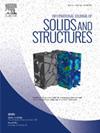A practical method for robust elastic characterisation of mortar in flat jack tests
IF 3.8
3区 工程技术
Q1 MECHANICS
International Journal of Solids and Structures
Pub Date : 2025-06-14
DOI:10.1016/j.ijsolstr.2025.113503
引用次数: 0
Abstract
Standard interpretations of in-situ flat jack tests rely on uniform stress states and only provide information on the mechanical properties of masonry as a composite and not those of its individual constituents. This paper develops a practical approach to identify the elastic characteristics of mortar using surface strain measurements (e.g. from Digital Image Correlation). It aims to provide robust identification under uncertain jack loads and stochastic material properties. A setup composed of three flat jacks inserted in masonry joints is explored in a micro-scale numerical model to develop the approach. The resulting surface strains are processed using the Virtual Fields Method to simultaneously and non-iteratively identify the mortar’s Young’s and shear modulus. Instead of the uncertain jack loads, mechanical properties of bricks, which are easy to obtain from laboratory testing of extracted samples, are used for the identification. The identified Young’s and shear moduli are robust against variations in jack penetration depth, measurement noise, stochastic material variability, and inaccuracies in brick properties. Poisson’s ratios are also identified, but less robustly, due to their limited influence on the measured strains. Finally, the use of VFM to reconstruct the uncertain jack forces is illustrated to deliver new insights on the applied loads during complex in-situ tests.
平板千斤顶试验中砂浆鲁棒弹性特性的实用方法
现场平板千斤顶测试的标准解释依赖于均匀应力状态,仅提供砌体作为复合材料的机械性能信息,而不是其单个组成部分的力学性能信息。本文开发了一种实用的方法来识别砂浆的弹性特性使用表面应变测量(例如从数字图像相关)。目的是在不确定千斤顶载荷和随机材料特性下提供鲁棒识别。在微观尺度的数值模型中,探讨了由三个插入砌体接缝的扁平千斤顶组成的装置来发展该方法。利用虚拟场法对得到的表面应变进行处理,同时非迭代地识别砂浆的杨氏模量和剪切模量。该方法不考虑千斤顶载荷的不确定性,而是利用从提取样品的实验室测试中容易获得的砖的力学性能进行鉴定。所确定的杨氏模量和剪切模量对于千斤顶穿透深度、测量噪声、随机材料变化和砖性能不准确的变化都是稳健的。泊松比也被确定,但不太可靠,因为它们对所测应变的影响有限。最后,利用VFM来重建不确定的千斤顶力,以提供在复杂的原位测试过程中施加载荷的新见解。
本文章由计算机程序翻译,如有差异,请以英文原文为准。
求助全文
约1分钟内获得全文
求助全文
来源期刊
CiteScore
6.70
自引率
8.30%
发文量
405
审稿时长
70 days
期刊介绍:
The International Journal of Solids and Structures has as its objective the publication and dissemination of original research in Mechanics of Solids and Structures as a field of Applied Science and Engineering. It fosters thus the exchange of ideas among workers in different parts of the world and also among workers who emphasize different aspects of the foundations and applications of the field.
Standing as it does at the cross-roads of Materials Science, Life Sciences, Mathematics, Physics and Engineering Design, the Mechanics of Solids and Structures is experiencing considerable growth as a result of recent technological advances. The Journal, by providing an international medium of communication, is encouraging this growth and is encompassing all aspects of the field from the more classical problems of structural analysis to mechanics of solids continually interacting with other media and including fracture, flow, wave propagation, heat transfer, thermal effects in solids, optimum design methods, model analysis, structural topology and numerical techniques. Interest extends to both inorganic and organic solids and structures.

 求助内容:
求助内容: 应助结果提醒方式:
应助结果提醒方式:


